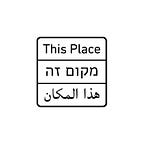Wendy Ewald about ‘This Place’.
‘This Place’ explores the complexity of Israel and the West Bank, as place and metaphor, through the eyes of twelve internationally acclaimed photographers. Their highly individualized works combine to create not a single, monolithic vision, but rather a diverse and fragmented portrait, alive to all the rifts and paradoxes of this important and much contested space.
The project follows in the tradition of such projects as the Mission Héliographique in nineteenth-century France and the Farm Security Administration in the United States, which gathered artists who use photography to ask essential questions about culture, society and the inner lives of individuals. Initiated by photographer Frederic Brenner, the completed project consists of a traveling exhibition, companion publications and a program of live events.
‘With time I’ve learned to back off from the world’, writes Wendy Ewald, ‘and let it reveal itself to me by giving cameras to my subjects to photograph’. For this project, she began by collaborating with students, teachers and families in five schools, including elementary schools in Nazareth and several military academies. Working with digital cameras for the first time made it possible for Ewald to extend her project to include fourteen communities and propose a collective portrait of life in Israel and the West Bank. She worked with shopkeepers in the Jerusalem market, Gypsy children in the Old City, elderly Palestinian women in East Jerusalem, high-tech workers in Tel Aviv, as well as additional schools. These communities eventually produced tens of thousands of images, along with writings and local exhibitions. Her book, ‘This Is Where I Live’, combines photographs made by the projects’ participants, their testimonies and Ewald’s portraits and extensive research.
1.Could you talk about why you joined ‘This Place’? What attracted you the most?
WE: I was very unsure about joining the project because Israel and the West Bank had been photographed so much. I was able to travel around the country before and I was attracted by Nazareth, the largest Arabic city. I’m generally attracted to places that visually and culturally draws me in. I loved all the photographs that were used to advertise food, music, landscape, and people.
2. What do you want to say with the photographs? What were your strongest feelings during and after this project?
WE: I was most interested in showing that Israel was a much more nuanced country and political environment than is normally portrayed. I’m excited when I’m able to see things in a completely different way - visually and historically.
3. What was your selection criteria for the places you chose in the project?
WE: I decided to train people to use simple cameras and take pictures of the life around them. From what I’d seen, photographs had been taken from an outside perspective and lacked the intimacy and complexity that I could see around me.
4. Could you share your shooting process with us — did you have any interesting experiences? Did you run into any difficulties?
WE: I began by working with Arab-Israeli school children and then young Israeli people in military academies. They were both very different and in the way that they made photographs. Yet there were some similarities — like the fact they made beautiful close-up pictures of flowers. I asked them to photograph their families, their community including holidays and their dreams or fantasies. We also discussed their successes and failures in their picture making.
When people heard about what I was doing, I was asked to work with other groups of people. In the end I worked with 14 different groups of people of different ages, ethnic groups, and locations. It was a surprise to me how open and easy people were to work with.
5. What kind of role do you want the photographs to play? Did you have any expectations as to the reaction of the viewers?
WE: I hope they provoke an emotional reaction and educate the readers about the complexity of what some people call Israel and the West Bank. I also hope they are surprised by the freshness and depth of the photographs.
6. In your opinion, what is the most important factor to ensure the success of a photographic project like ‘This Place’?
WE: I think a project like ‘This Place’ is very tricky. I think all the participants have to be flexible, open and respect each other.
7. What are some current things happening in your work and daily life? And how would you evaluate yourself in this project?
WE: My work in ‘This Place’ is a continuation of work I’ve done in the past but this time I was able to look at a whole country in conflict from inside many different groups. My work was different from the others because I was able to gain more access than the others because of the process used.
8. How does it feel to have an exhibition opening?
WE: It’s a bit difficult because as an artist you want to communicate your ideas as fully as possible. That’s never possible. There’s always a gap, but still it’s good that people are thinking more about these issues.
9. Do you have any plans after ‘This Place’, what comes next?
WE: I am starting on two new books — one about my own family in the 1960s in Detroit and another with students I worked with in the 70s who are now in their late 40s. It’s very interesting to me to work over time with such an instant medium.
Discover more of the project on this-place.org
Follow This Place on Twitter, connect via Instagram and Facebook or follow along on Medium.
